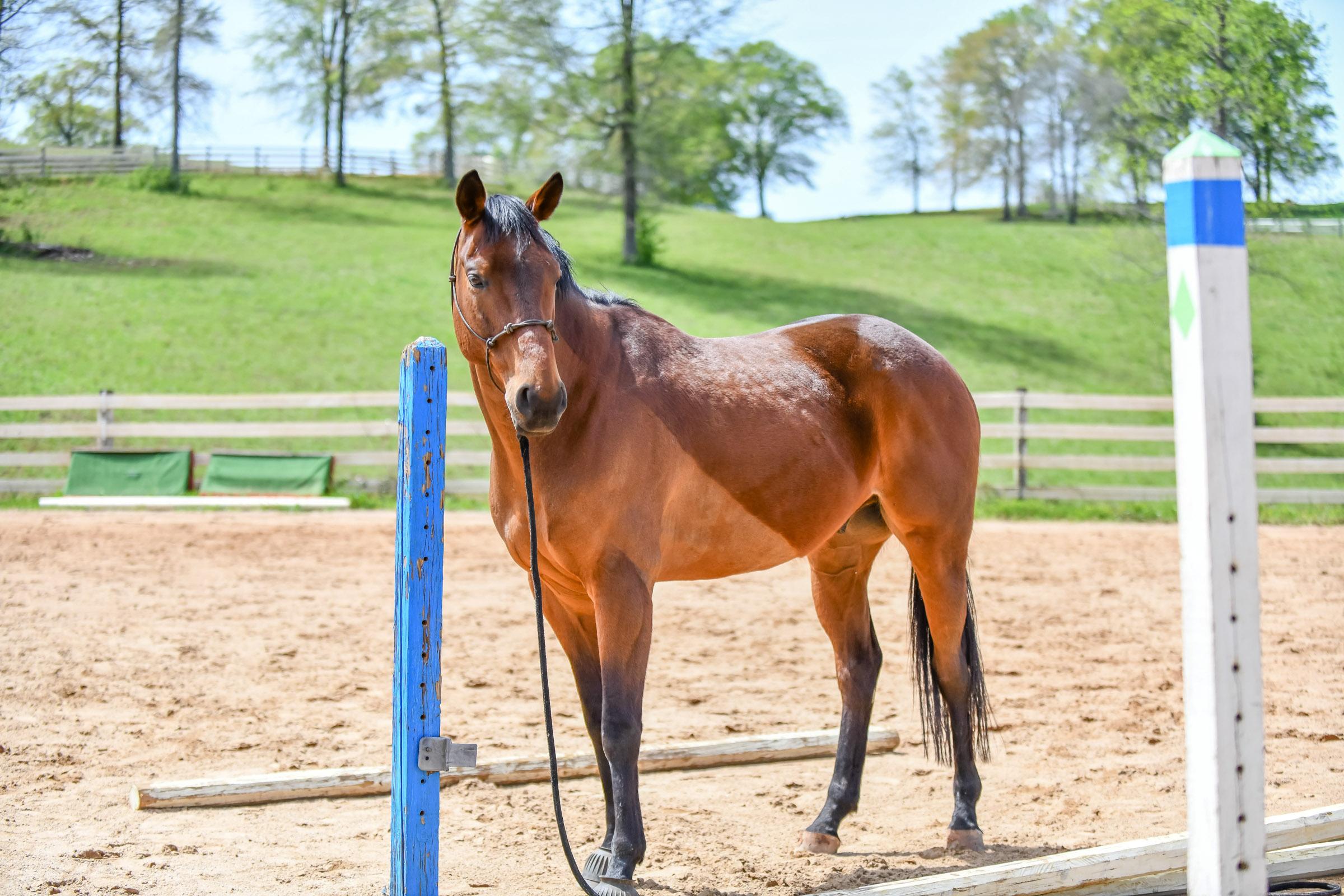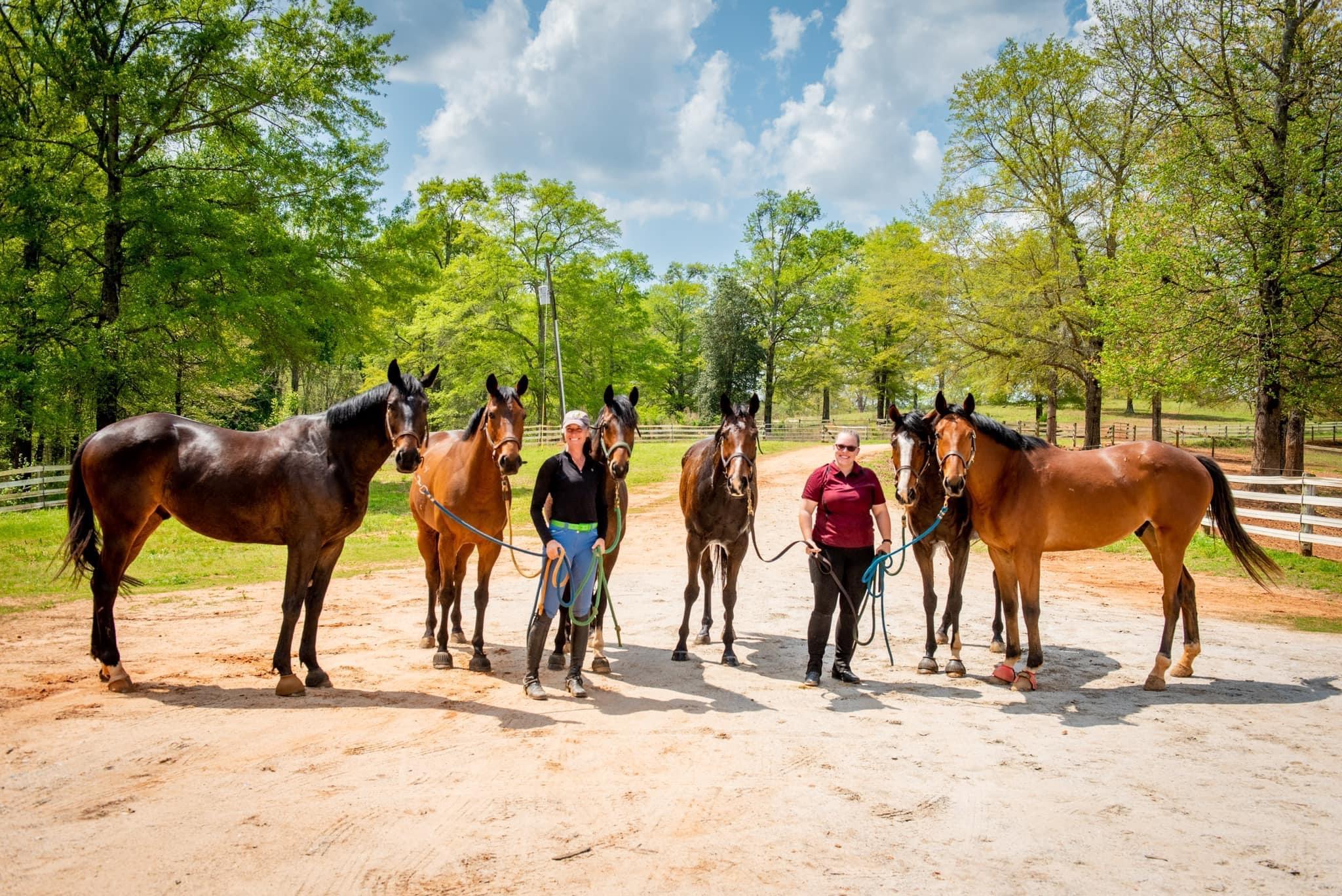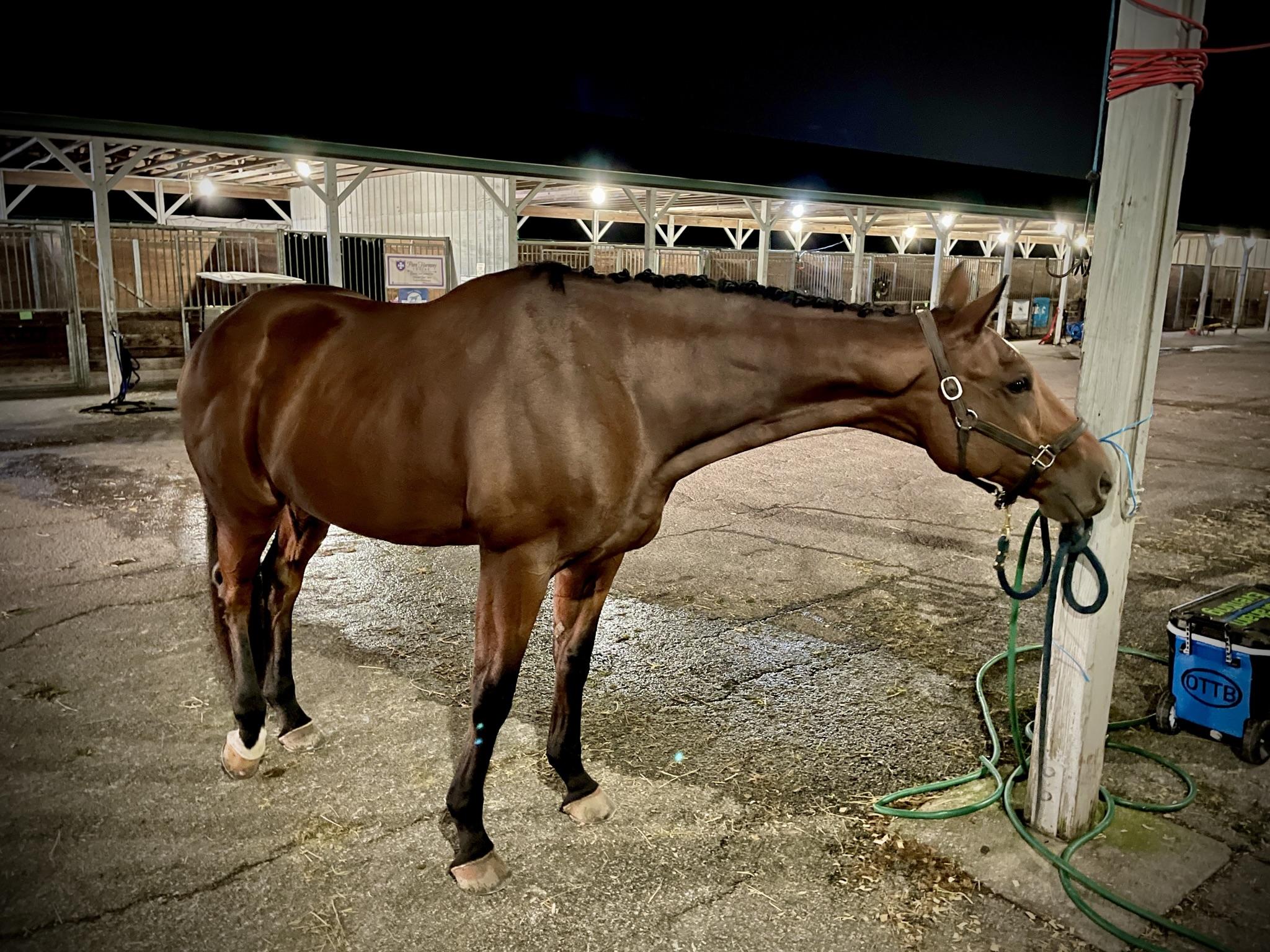
Thoroughbred Logic: The Art of Tying
“… what I do create here, and what this article is about, is a horse who ties well enough, ground ties well enough, and learns to stay calm and independent whether there is pressure on the other end of their line or not.”
Welcome to the next installment of Thoroughbred Logic. In this weekly series, Anthropologist and trainer Aubrey Graham, of Kivu Sport Horses, offers insight and training experience when it comes to working with Thoroughbreds (although much will apply to all breeds). This week, come along for the ride as Aubrey offers her logic on teaching horses to tie.
During the last Thoroughbred Logic Clinic, part of the “ground work demo” focused on lunging the horse for attention and communication. At the time I think we had around eight Thoroughbreds in my not-huge arena, and I had Rhodie (Western Ridge) as my demo horse. After the explanation, I looked around and realized that I needed to go help without a horse in hand. I draped Rhodie’s long lead rope over a cross rail, said “stand” (equine equivalent of a dog’s “stay”), complete with the “stop” hand signal. Then I wandered off to teach the horse and rider pairs for the next twenty minutes.
Rhodie stayed.

Rhodie (Western Ridge) just hanging out amongst the clinic chaos. Good kid. Photo by Cora Williamson.
In fact, he barely moved his feet — he just followed me and the participants with his ears and eyes and waited patiently until I was done. Madigan (Madigan Cat) had done pretty much the same thing at the clinic prior. Asked to stay with the reins over his wither, the four year old with three months of training just hung out while a half a dozen other horses moved around him.
In other incidences, folks have come to look at horses, and while showing them others in the barn, I lead them out of their stalls, drop the rope, and remind the horses to “stand” while they get examined by potentially interested clients. I suppose I get a kick out of the human reactions — trying to hold the rope, worried that if we walk behind them they will peace out. I get it. But the horses (at least most of them) don’t move.

Q (Quality Step) not budging while I had to dismount and chase the pig out of the paddock. Yes, it’s an odd life I live here some days. Photo by Kelly Robison.
Technically, I would not say that any of my horses, those two clinic demo horses included, ground tie perfectly. I am not an expert at training that skill, but I do train the “idea” of it, daily — with all of them. I have more Western educated friends who are legit tying experts (ahem, Jennifer Kelly), complete with the strategic and appropriate use of tie blockers and patience poles. Through consistent and hard-won training, they create horses that will stand tied to a trailer for hours. They are damn good at that. I am not.
That said, what I do create here, and what this article is about, is a horse who ties well enough, ground ties well enough, and learns to stay calm and independent whether there is pressure on the other end of their line or not. And the way we do that here is simply through incremental work, high expectations, clear boundaries and absolute daily consistency.
Keep in mind that Thoroughbreds coming off the track usually know how to straight tie in a stall. They are often “hooked to the wall” when tacked, groomed, or when their stalls are cleaned. The ability to straight tie within a confined space, therefore, is already part of their vocabulary. Cross tying is a whole other can of worms, though usually, this is a process that doesn’t take these kids long to learn.
When teaching horses to crosstie, and for safety sake throughout, I leave the lead rope attached to the halter and draped over their withers. Moreover, I have quick release cross ties attached to hay string (as I never fully trust the quick release to do its job when necessary). Keeping the lead rope attached allows me to grab something other than the crossties should they “have a moment,” and it allows me to direct them from a point of pressure with which they are familiar.
While cross tying, I stay with them and literally work to teach a vocabulary, like I would for a dog. “Stand” means literally that — but it also means stop moving your feet. Should they be antsy, I drop them off one side of the cross ties and keep them in place with the lead rope while I groom. A gentle tug correction on the line, like I would use when walking, reminds them that I need them to stop mucking about and focus.
While this extraordinarily simple process trains horses who will eventually fall asleep when crosstied, there are a few caveats. The first is that I categorically hate micromanagement. I do not nitpick with the rope, hold their halter, or consistently guide their shoulder. So, if they want to walk forward and test the ties, great. If they get super fussy, I’ll give them a correction and then reward them when they stand still with a pat or a scratch on the neck.
But importantly, once I familiarize them with the idea, I expect them to stand. As far as I’m concerned, a micromanaged horse won’t learn to tie. They have to learn to be independent and with that, patient. That expectation allows me to not gasp when they take a step into pressure — they will figure it out. And they can’t do that if they don’t know where the boundaries are.

Three-in-hand is a pretty regular task around here. Photo of Laura Newell, myself and all the Winchester Place Thoroughbreds by Kelly Robison.
The other way I teach tying around here happens amidst the chaos. I am one person, and while I have a few barn helpers who are freakin phenomenal, I never have enough hands on deck. No one leads all of these horses one-by-one, and I’m usually the idiot who will take three or four out at a time. Sometimes that feels like a 1200-lb-cat-herding-rodeo, but mostly they are good(ish). Getting them in and out of their stalls while holding onto two-to-three other lines, though, creates moments to train and also to test their tying skills.
While I go in a stall to put a halter and fly mask on, I will drape the lead of the other horse in hand over the top of the bucket hanger. This keeps the rope up and in easy grabbing distance, and also when smushed a bit against the wall, creates enough tension on the line to mimic a very loose tie blocker without actually jamming between the bucket and the wall. Each horse outside the stall is neither allowed into the stall nor permitted to walk off. Each is told to “stand” and corrected with a tug of the lead if they try to wander.

Standard bringing-in chaos. Nemo (Unregistered), Aspen (Aspenfiveoneseven) and Curry (Curlin Lane) have been told to stand while I stick Uno (Hold ‘Em Paul — the gray) in a stall. Photo by author.
My expectation is that they will stand. So, I give a clear ask and then leave them alone. There is no micromanaging, no checking in — just “stand” — and then I go in the stall, get the other horse ready, and then regain the first lead rope to lead the group out to the field calmly.
The consistency of language, expectation and clear parameters make these horses able to understand the job. Thus, when I do tie them — when I hook a horse up to a straight tie loop in the barn or tie them to the trailer or a post while we tack at a show — I know that they have a concept of the expectation to “stand.” And then from there, as mentioned above, I let them “figure it out” (but always keep the lead rope attached and tie quick releases attached to hay string for safety sake).

Boomer (Vanderboom Ridge) straight tying to hay string while getting ready for an early dressage test at the Kentucky Horse Park during the 2021 Retired Racehorse Project MegaMakeover. Photo by author.
This “figure it out” process is an important one, as it enables them to test their boundaries and to have them upheld. And in this process, they will get it wrong from time to time, but they will also learn to get it right.
Sure, occasionally they will pull back and sometimes not come forward fast enough resulting in a broken halter — or they will go forward too far and break the crossties off their hay string; they might even wander off when I go in the stall to get the next horse. But staying calm while reminding them of their manners and their job means that they will learn as they get hooked back up and held to the same expectation. Sure, I’ll help them work through any fear or confusion, but in this process, they come to understand that despite their behavior and new knowledge of the boundaries, the ask (requirement to “stand”) hasn’t changed.
As a result, the horses learn the meaning and limits of a term (“stand”) and gain the versatility to literally channel their inner golden retriever and STAY when asked, whether ground tied, straight tied, or cross tied. Is it a perfect system? Nope. But is it consistent enough to produce a barn full of young Thoroughbreds who understand their jobs and will stand still through general chaos? Absolutely.









